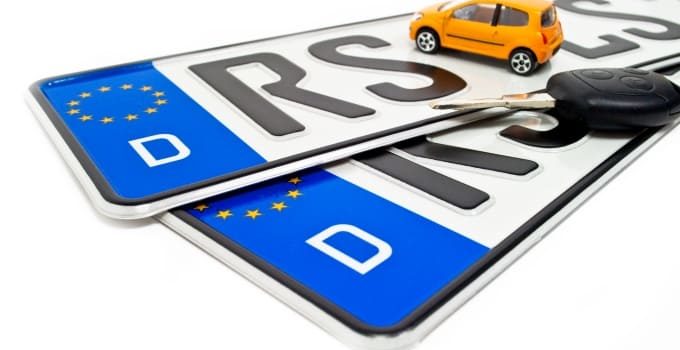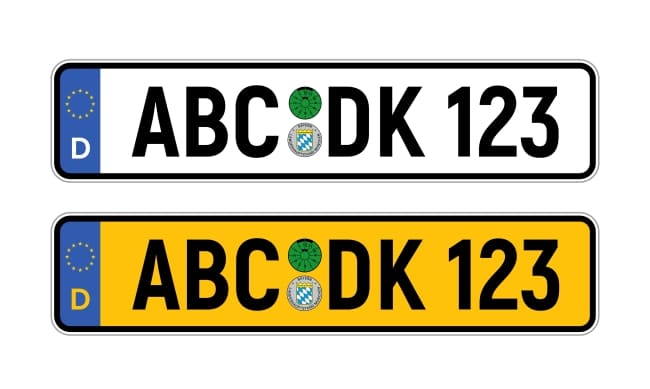
So that authorities can assign vehicles to their vehicle owner and generally distinguish them from one another, there are so-called vehicle registration plates, also known as license plates. Anyone who wants to legally participate in traffic in The United Kingdom must ensure that it is attached to the car. The vehicle registration office allocates the number plate. But how are the numbers and letters put together and what do they mean? This will be discussed below.
Contents
The classic numberplate
The license plate established on German roads can be recognized on a white background by its blue area with the Euro emblem, on which the country code DE is specified. It must not be obscured by dirt or covers and must be affixed to both the front and rear of the vehicle. The structure of the official license plate consists of a distinguishing sign that marks the administrative district and an identification number. The former has two to three letters, the latter a maximum of two letters and up to four digits. The identification number is assigned at random, but can be individualized according to the needs of the owner. All in all, the signs should not consist of more than eight characters.
Red, green, yellow – what do the colored license plates mean?

In addition to the classic Euro number plate, which is the most common sight here on the street, there are some special car number plates that differ in color. The special license plates always serve a specific purpose: Red license plates, for example, are reserved for dealers with whom unregistered vehicles can carry out test drives and transfers. Private individuals, on the other hand, have to resort to so-called short-term license plates for this project, which can be recognized by a yellow box on the far right at the end of the plate and on which the expiry date of the license plate is noted in black letters. It is valid for a maximum of five days. The export license plate works according to the same principle, except that the date can be seen on a red area. It is primarily used for transferring the car abroad, which must be done by the specified date. These two number plates are combined under the term transfer number plate. Green number plates are less common; they mark tax-exempt vehicles that are used, for example, for agricultural and forestry purposes. You can apply to the registration authority for exemption from this vehicle tax. But watch out: Vehicles with a green number plate may only be used within certain limits. As soon as the original purpose, such as the transport of agricultural goods, is ignored and inappropriate objects are transported instead, this is considered a case of tax evasion. Other types of license plates that are not linked to any color scheme but still have special features are seasonal and variable license plates. Vehicles with seasonal license plates are valid for at least two months, but no more than 11 months. The car may only be used during this period and must be parked away from it on private property. This is particularly useful from an insurance point of view, because the owner saves fees and reduces the administrative workload of the insurance authorities. The exchange plate is based on the idea that two cars can be registered on one and the same license plate. In this case, it should be noted that the vehicles must not be in use at the same time. Another striking feature are diplomatic license plates: these feature specific codes, usually starting with a zero, followed by a country code and a rank at the end, indicating the importance of the vehicle owner's position. The lower the number, the higher the position of the holder.
What needs to be considered when changing a license plate?
There are many reasons why you might need to change license plates. The most obvious reason for a change is probably a change of residence to a different registration district, but a change of ownership also requires an innovation. In addition, the banal desire for an individualized license plate can lead to a visit to the authorities. As a rule, there are only a few limits to the independent choice of identification numbers, but there are still one or the other requirement from district to district. The Vehicle Registration Ordinance (FZV) regulates, for example, that the letter combinations must not be offensive to other people and must not cause offense. Certain combinations of numbers or abbreviations on license plates that obviously have a hidden, politically inappropriate meaning – and serve, for example, to glorify German history – are also prohibited. In addition, the availability of the desired number plate can be easily determined on the website of the registration office. Simply enter and it will be displayed whether the combination is already occupied. In the course of this, vehicle owners can try out other combinations that meet their own wishes. A certain entertainment value can certainly be made a selection criterion, but in most cases the characters are initials with a personal meaning. If it is not yet occupied, the license plate can be reserved and kept free by telephone or online with the authority. The only downside to this is that choosing a self-contained license plate as opposed to a randomly generated one is chargeable. However, the costs are in the low double-digits.
Mount the license plate yourself on the car

Since number plate changes are common for various reasons, it is useful to know how to apply them to the car yourself. Therefore, the following instructions for changing the number plates should provide assistance. The holder of the sign can be unscrewed with a narrow slotted screwdriver; in many cases, the fitting can also be done by hand. To do this, the flexible brackets are simply bent down, the number plate pulled out and the new one inserted flush under the rigid brackets. The moveable brackets are then pushed out of the holder to secure the license plate. If a panel is attached to the underside and all other components are rigid, the license plate is inserted from below and subsequently reattached when the panel is attached. For a bracket with a three-sided frame bezel, use the screwdriver to open the notches on the side. The new sign is then placed in the holder from top to bottom. Mounting without a bracket is recommended primarily for aesthetic reasons. Attached directly to the body, the sign sits firmly and securely on the car. However, this method requires a little more manual skill, which is why laypeople should opt for a holder. But once you have determined which bracket you are dealing with, you can quickly replace it yourself!
